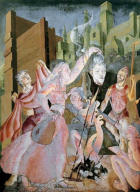



All texts copyright Richard Shillitoe
judith showing the head of
holofernes 1929
Oil on canvas.
48 x 36in. (121.92 x 91.44cm.)
Provenance
University of London: College Art Collections.
Exhibited
London, Royal Academy, 1931, no. 197.
London, Whitechapel Art Gallery, 1935, no. 14.
The painting was awarded equal first prize in the Summer Composition Prize, Slade School of Art (1929). The
joint prize winner was Elizabeth Leslie Arnold, about whom nothing further is known at present.
The Summer Composition Prize was the most prestigious of the Slade competitions. It was intended to
develop skills in large-scale figure compositions and as a continuation of the tradition of history paintings.
In keeping with this, the set titles for the competition were usually drawn from the Bible or the classics.
The story of Judith and Holofernes can be found in the Book of Judith, one of the Apocryphal books of the
Old Testament. During the siege of the town of Bethulia by the Assyrian general Holofernes, Judith, a young
widow of the town, went to him, enchanted him with her beauty and allure and then de-capitated him in
his bed whilst he lay in a drunken stupor. Her patriotic deed inspired her countrymen to rise up and rout the
invading army, thereby saving the city.
Colquhoun has taken great care to paint the scene just as described in the Old Testament verses.
Judith is shown wearing the outfit in which she set out to captivate Holofernes:
And she took sandals upon her feet, and put about her her bracelets, and her chains, and
her rings, and her earrings, and all her ornaments, and decked herself bravely, to allure the
eyes of all men that should see her. (10.4)
She shows the moment when Judith and her maid return to the gates of Bethulia to announce the success of
her mission. The elders of the city have heard them arrive:
And then they ran all together, both small and great, for it was strange unto them that she
was come: so they opened the gate, and received them, and made a fire for a light, and
stood round about them. (13.15)
The maid carries the canopy torn from Holofernes’ bed, whilst Judith takes out the head from her meat bag
and holds it aloft in triumph:
So she took the head out of the bag, and shewed it, and said unto them, behold the head of
Holofernes, the chief captain of the army of Assur, and behold the canopy, wherein he did
lie in his drunkenness; and the Lord hath smitten him by the hand of a woman. (13.15)
The painting incorporates the golden section. The psychological crux of the painting is the triumphal stare
in Judith’s eyes as she holds aloft the severed head. The eyes of Holofernes, who looked at Judith with lust
and paid for it with his life, are level with those of Judith. Both pairs of eyes are placed at the golden
section of the height of the painting.
The motif of a severed head spouting blood (this time, a woman’s) was later used as the design for the
preview invitation for the joint exhibition with Roland Penrose in 1939.
The paint is very thin, making the underlying pencil grid clearly visible. A sketch, squared for enlargement
and several ink studies are known.
The painting was the subject of a cartoon in Punch magazine, 20 May 1931, on the occasion of its exhibition
at the Royal Academy.


















